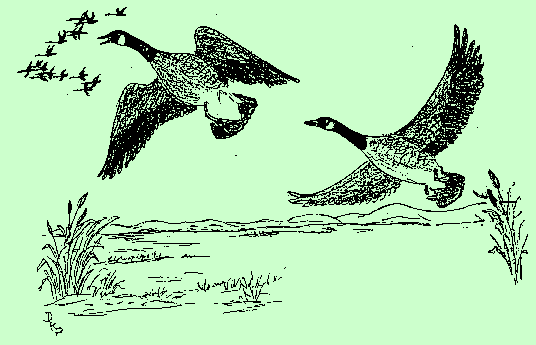The Canada Goose

L: 16 - 25" -- W: 50 - 68"
Large gray-brown goose with black head and neck ("stocking") with a white patch ("chin strap") running onto each side of the head. Breast is light colored, white is all around the base of the tail. Bill and legs black. Sexes are alike. They mate for life -- if one is killed, the other joins a bachelor flock. Pairs often adopt other baby geese to raise.
Voice: a loud, resonant "ka-ronk", which can be heard as far as a mile.
Food: grains, grass sprouts, marine vegetation.
![]()
![]() "Wild Geese" to most of us are the Canadas which are boldly patterned with
a gray-brown body, black head and neck, and a white chin strap which extends
up the side of the cheek. There are ten races, and the Utah race is among
the large ones. Wing spread is up to six feet. When a flock is in flight
it usually is in a V-formation so each bird has a good view forward, or in a
long undulating line. Wise old ganders are usually in the lead, and in
migration take their flocks over the Pacific, Central Mississippi, and
Atlantic flyways.
"Wild Geese" to most of us are the Canadas which are boldly patterned with
a gray-brown body, black head and neck, and a white chin strap which extends
up the side of the cheek. There are ten races, and the Utah race is among
the large ones. Wing spread is up to six feet. When a flock is in flight
it usually is in a V-formation so each bird has a good view forward, or in a
long undulating line. Wise old ganders are usually in the lead, and in
migration take their flocks over the Pacific, Central Mississippi, and
Atlantic flyways.
Rachel Field, a well-known author wrote:"Something told the wild geese
It was time to go;
Though the fields lay golden
Something whispered, -- "snow".Leaves were green and stirring,
Berries, luster-glossed,
But beneath warm feathers
Something cautioned, -- "frost".All the sagging orchards
Steamed with amber spice,
But each wild breast stiffened
At remembered ice.Something told the wild geese
It was time to fly --
Summer sun was on their wings,
Winter in their cry.
REFERENCES:
The Canada Goose
Roger Tory Peterson
National Geographic -- Swans and Geese
S. Dillon Ripley